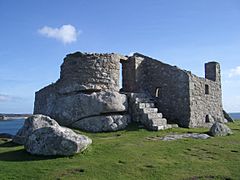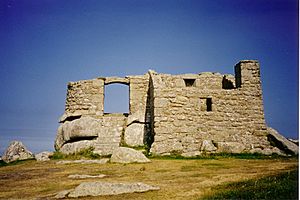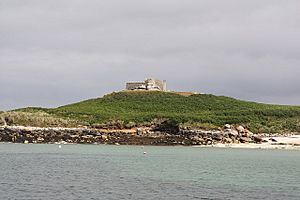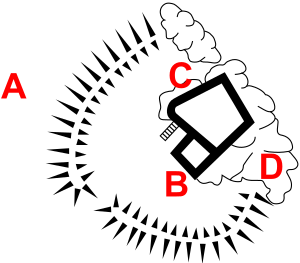Old Blockhouse facts for kids
Quick facts for kids Old Blockhouse |
|
|---|---|
| Tresco in the Isles of Scilly | |

Old Blockhouse, viewed from the north-west
|
|
|
Shown within the Isles of Scilly
|
|
| Coordinates | 49°57′31″N 6°19′39″W / 49.95856°N 6.32755°W |
| Type | Gun tower |
| Site information | |
| Owner | English Heritage |
| Open to the public |
Yes |
| Condition | Ruined |
| Site history | |
| Materials | Granite |
| Events | 1651 invasion of the Scilly Isles |
The Old Blockhouse, also called the Dover Fort, is an old fortification (a strong building for defense) on the island of Tresco. It's part of the Isles of Scilly, a group of islands off the coast of Cornwall, England. This fort was built between 1548 and 1551. It was ordered by the government of King Edward VI to protect the islands from attacks, especially from France.
The blockhouse was built on a high, rocky spot. It looked over Old Grimsby harbour and a nearby anchorage called St Helen's Pool. It had a platform for two or three cannons. These cannons would have fired at enemy ships. There was also an earth bank and a stone wall. These were built to protect the fort from attacks from the beach and land. Later, a small room was added. This room was for the soldiers who lived there.
During a time called the Interregnum (when England had no king), the Old Blockhouse was used by the Royalists. These were people who supported the king during the English Civil War. In 1651, the fort was attacked by Parliamentary forces. These forces were led by Sir Robert Blake. Blake's naval guns (cannons on ships) could shoot further than the fort's guns. After a tough fight, the blockhouse was captured.
The blockhouse kept its cannons until at least the 1750s. But by the late 1700s, it was no longer used and was falling apart. In 1922, the blockhouse was put under the care of the state. Today, English Heritage looks after it. You can visit it as a tourist. It's also protected as a scheduled monument under UK law. This means it's an important historical site.
Contents
History of the Old Blockhouse
Why the Fort Was Built
The Old Blockhouse was built between 1548 and 1551. Its main purpose was to protect the Scilly Isles from French attacks. Tensions with France had grown during the time of King Henry VIII. War broke out in 1538. King Henry had built new forts along England's coasts. These forts were designed to defend against the powerful, long-range cannons of the time.
Henry's son, Edward VI, became king in 1547. He was only nine years old. England was still at war with France. Edward Seymour was made the King's Lord Protector. This meant he ruled for the young king. Edward Seymour's brother, Thomas, became England's top naval officer, the Lord Admiral. Thomas visited the Scilly Isles himself. He decided they were easy targets for a French invasion.
Because of this, Sir Francis Flemming was put in charge of improving the islands' defenses. This happened in February 1558. Money for the building work came from the dissolution of the monasteries (when monasteries were closed down). The first building work was on Tresco island. John Killigrew, who was captain of Pendennis Castle, led the project. Tresco needed modern defenses. Killigrew also wanted to gain more political power on the island.
The Old Blockhouse was part of this building plan. It was placed on high ground. This allowed it to protect Old Grimsby harbour. It also overlooked the nearby St Helen's Pool. Once finished, it held two or three cannons. These cannons could fire at ships trying to enter the harbour. They could also shoot at ships approaching the Scilly Isles from the northeast.
Edward Seymour lost his power in 1549. A new survey of the forts was done by Captain William Tyrell. This was to check if the new forts were in the right places. Building work continued across the Scilly Isles. It also spread to the island of St Mary's. Many oak trees were sent from South Wales in 1550. The islands didn't have enough wood for building. In 1551, orders were given to send bows, arrows and gunpowder ingredients. Construction teams kept working until the end of 1552.
The Old Blockhouse seems to have been completed. But the government was running out of money. So, in late 1552, they decided to stop spending more on the Scilly Isles. Between 1548 and 1552, about £3,123 was spent on the forts. A survey in 1579 said the total cost, including soldiers, was about £6,000. King Edward's sister, Queen Mary I, wanted to have 150 soldiers on the islands. But we don't know if that many soldiers ever lived there.
The Blockhouse in Battle (17th Century)
The Old Blockhouse saw real fighting in 1651. This was during the Interregnum, after the English Civil War. It's one of the few English coastal forts that actually fought in a battle.
The Scilly Isles supported King Charles I during the civil war. After a short time under Parliament's control, they rebelled for the King in 1648. Tresco became a base for Royalist privateers. These were private ships allowed to attack enemy ships. Parliament worried that the Dutch, who were not friendly to England, might take the islands. This would give them a base to attack England. So, in 1651, Parliament sent Sir Robert Blake. He led a naval force to take back the islands.
Blake arrived at St Helen's Pool in April 1651. He planned to take Tresco island. He attacked Old Grimsby harbour and the blockhouse. Blake sent soldiers in small boats. But they landed on the wrong island and had to go back. The next day, the soldiers landed on the beaches below the blockhouse. There was fierce fighting, and the attackers were pushed back. Blake's men tried another landing. This also met strong resistance. The blockhouse's cannons probably fired at the landing parties. About 15 of Blake's soldiers were killed. But Blake's ships had cannons that could shoot further than the fort's. Old Grimsby soon fell. Blake then used Tresco as a base to capture St Mary's.
The blockhouse remained an important fort after this invasion. Parliament spent £1,050 on the islands' defenses. A survey in 1652 called the blockhouse the "Dover Fort." In 1660, King Charles II was put back on the throne. Edward Sherburne was sent to inspect the Scilly Isles' defenses. He suggested that the Old Blockhouse needed repairs.
Later Years (18th-21st Centuries)
The Crown (the government led by the King or Queen) leased the islands in 1687. They were leased to the Godolphin family, and later to August Smith in 1831. Christian Lilly inspected the blockhouse in 1715. He was sent by the Duke of Marlborough. Lilly reported that the fort was "very much decayed" (falling apart). Only the walls were standing. But he suggested repairing it for £28.
The historian William Borlase visited in 1752. He noted that the Old Blockhouse still had cannons guarding the harbour. But by the end of the century, when writer John Troutbeck saw the site, the cannons were gone. However, the blockhouse walls were still in good shape. Troutbeck thought it could still be useful for military purposes if it was fixed up.
In 1922, Arthur Dorrien-Smith took over the lease. He agreed to put several properties on Tresco, including the blockhouse, under the care of the Ministry of Works. Today, the blockhouse is looked after by English Heritage. This group is the successor to the Ministry of Works. The Old Blockhouse is open for tourists to visit. It is protected as a scheduled monument under UK law.
How the Blockhouse Was Built
The Old Blockhouse has a paved, square platform for cannons. It's about 7 meters (23 feet) by 6.5 meters (21 feet). The walls are made of granite and are 1 meter (3 feet) thick. They were probably taller when first built. The fort sits on top of a rocky outcrop (a piece of rock sticking out). This outcrop forms the lower part of the walls. You reach the platform by stairs. The platform originally had embrasures (openings for cannons) on the northwest and northeast corners. The walls probably formed a parapet (a low protective wall). It's possible there was also a roof over the platform.
In the southwest corner of the platform, there's a lean-to (a small shed-like structure). This might have been a powder locker (for storing gunpowder) or a shelter for the soldiers on watch. A small space in the south wall might have also stored ammunition. A small room, about 2.8 meters (9 feet) by 3.6 meters (12 feet), was added later to the west side. This was after the main building was finished. It might have been added during the English Civil War. This room had windows and a fireplace. It would have been living quarters for the soldiers.
An earth bank defends the side of the blockhouse facing the land. This bank is between about 0.5 meters (1.6 feet) and 2 meters (6.5 feet) high. It's similar to banks found around forts from this time along the Thames River in England. There are also parts of a defensive stone wall on the side facing the sea. But much of this wall has been destroyed by coastal erosion (when the sea wears away the land).
The design of the blockhouse was quite old-fashioned for its time. It looked like the forts built during King Henry VIII's reign. This is different from a nearby fort called Harry's Walls. Harry's Walls was built at the same time as the blockhouse. But it used a more modern design with bastions (parts of a fort that stick out to allow defenders to fire along the walls).





